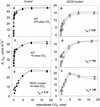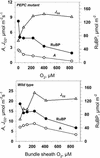Bundle sheath diffusive resistance to CO(2) and effectiveness of C(4) photosynthesis and refixation of photorespired CO(2) in a C(4) cycle mutant and wild-type Amaranthus edulis
- PMID: 12376660
- PMCID: PMC166622
- DOI: 10.1104/pp.008201
Bundle sheath diffusive resistance to CO(2) and effectiveness of C(4) photosynthesis and refixation of photorespired CO(2) in a C(4) cycle mutant and wild-type Amaranthus edulis
Erratum in
- Plant Physiol. 2003 May;132(1):400
Abstract
A mutant of the NAD-malic enzyme-type C(4) plant, Amaranthus edulis, which lacks phosphoenolpyruvate carboxylase (PEPC) in the mesophyll cells was studied. Analysis of CO(2) response curves of photosynthesis of the mutant, which has normal Kranz anatomy but lacks a functional C(4) cycle, provided a direct means of determining the liquid phase-diffusive resistance of atmospheric CO(2) to sites of ribulose 1,5-bisphosphate carboxylation inside bundle sheath (BS) chloroplasts (r(bs)) within intact plants. Comparisons were made with excised shoots of wild-type plants fed 3,3-dichloro-2-(dihydroxyphosphinoyl-methyl)-propenoate, an inhibitor of PEPC. Values of r(bs) in A. edulis were 70 to 180 m(2) s(-1) mol(-1), increasing as the leaf matured. This is about 70-fold higher than the liquid phase resistance for diffusion of CO(2) to Rubisco in mesophyll cells of C(3) plants. The values of r(bs) in A. edulis are sufficient for C(4) photosynthesis to elevate CO(2) in BS cells and to minimize photorespiration. The calculated CO(2) concentration in BS cells, which is dependent on input of r(bs), was about 2,000 microbar under maximum rates of CO(2) fixation, which is about six times the ambient level of CO(2). High re-assimilation of photorespired CO(2) was demonstrated in both mutant and wild-type plants at limiting CO(2) concentrations, which can be explained by high r(bs). Increasing O(2) from near zero up to ambient levels under low CO(2), resulted in an increase in the gross rate of O(2) evolution measured by chlorophyll fluorescence analysis in the PEPC mutant; this increase was simulated from a Rubisco kinetic model, which indicates effective refixation of photorespired CO(2) in BS cells.
Figures












Similar articles
-
Coleataenia prionitis, a C4-like species in the Poaceae.Photosynth Res. 2021 Feb;147(2):211-227. doi: 10.1007/s11120-020-00808-w. Epub 2021 Jan 3. Photosynth Res. 2021. PMID: 33393063
-
Photosynthesis with single-rooted Amaranthus leaves. II. Regulation of ribuelose-1,5-bisphosphate carboxylase, phosphoenolpyruvate carboxylase, NAD-malic enzyme and NAD-malate dehydrogenase and coordination between PCR and C4 photosynthetic metabolism in response to changes in the source-sink balance.Plant Cell Physiol. 2002 Nov;43(11):1293-301. doi: 10.1093/pcp/pcf153. Plant Cell Physiol. 2002. PMID: 12461129
-
Development of structural and biochemical characteristics of C(4) photosynthesis in two types of Kranz anatomy in genus Suaeda (family Chenopodiaceae).J Exp Bot. 2011 May;62(9):3197-212. doi: 10.1093/jxb/err021. Epub 2011 Feb 16. J Exp Bot. 2011. PMID: 21325606
-
Overexpression of C(4)-cycle enzymes in transgenic C(3) plants: a biotechnological approach to improve C(3)-photosynthesis.J Exp Bot. 2002 Apr;53(369):591-607. doi: 10.1093/jexbot/53.369.591. J Exp Bot. 2002. PMID: 11886879 Review.
-
C(4) photosynthesis: principles of CO(2) concentration and prospects for its introduction into C(3) plants.J Exp Bot. 2002 Apr;53(369):581-90. doi: 10.1093/jexbot/53.369.581. J Exp Bot. 2002. PMID: 11886878 Review.
Cited by
-
Using Carbon Stable Isotopes to Study C3 and C4 Photosynthesis: Models and Calculations.Methods Mol Biol. 2024;2790:163-211. doi: 10.1007/978-1-0716-3790-6_10. Methods Mol Biol. 2024. PMID: 38649572
-
Diffusion of CO2 across the Mesophyll-Bundle Sheath Cell Interface in a C4 Plant with Genetically Reduced PEP Carboxylase Activity.Plant Physiol. 2018 Sep;178(1):72-81. doi: 10.1104/pp.18.00618. Epub 2018 Jul 17. Plant Physiol. 2018. PMID: 30018172 Free PMC article.
-
Photosynthesis, productivity, and yield of maize are not affected by open-air elevation of CO2 concentration in the absence of drought.Plant Physiol. 2006 Feb;140(2):779-90. doi: 10.1104/pp.105.073957. Epub 2006 Jan 11. Plant Physiol. 2006. PMID: 16407441 Free PMC article.
-
Bundle-sheath leakiness and intrinsic water use efficiency of a perennial C4 grass are increased at high vapour pressure deficit during growth.J Exp Bot. 2017 Jan;68(2):321-333. doi: 10.1093/jxb/erw417. Epub 2016 Nov 17. J Exp Bot. 2017. PMID: 27864539 Free PMC article.
-
Mehler reaction plays a role in C3 and C4 photosynthesis under shade and low CO2.Photosynth Res. 2021 Aug;149(1-2):171-185. doi: 10.1007/s11120-021-00819-1. Epub 2021 Feb 3. Photosynth Res. 2021. PMID: 33534052
References
-
- Brown RH. Analysis of bundle sheath conductance and C4 photosynthesis using a PEP-carboxylase inhibitor. Aust J Plant Physiol. 1997;24:549–554.
-
- Dever LV, Blackwell RD, Fullwood NJ, Lacuesta M, Leegood RC, Onek LA, Pearson M, Lea PJ. The isolation and characterization of mutants of the C4 photosynthetic pathway. J Exp Bot. 1995;46:1363–1376.
-
- Edwards GE, Baker NR. Can CO2 assimilation in maize leaves be predicted accurately from chlorophyll fluorescence analysis? Photosynth Res. 1993;37:89–102. - PubMed
Publication types
MeSH terms
Substances
LinkOut - more resources
Full Text Sources
Miscellaneous

